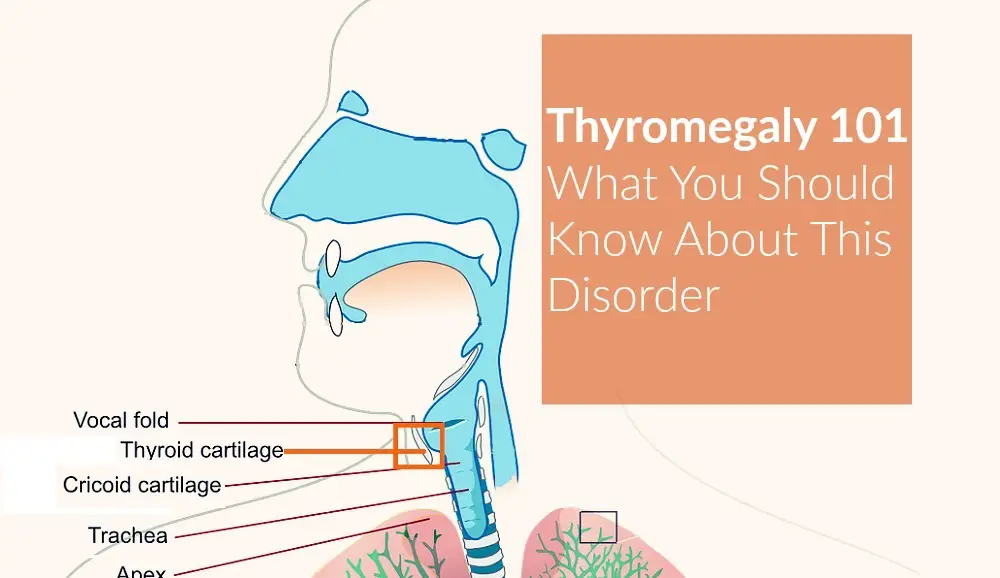The thyroid gland is among the most important glands in your body and it manufactures the thyroid hormone.
According to Medscape, thyromegaly or goiter is as a result of your thyroid gland growing bigger than it should.
The thyroid gland is butterfly shaped and is located below your Adam’s apple in the lower part of the neck.
More women suffer from this condition when compared to men and it can be caused by several factors such as iodine deficiency in your body, family history, hypothyroidism, and taking some medications for a long time.(1)
Therefore, it is important to know what causes this disease, determine whether it is cancerous, and how you can get treatment.
Thyromegaly Explained
Many normal people have this disease that arises due to abnormalities in the thyroid gland and causes a soft mass of tissue to develop on the lower part of the neck.
Most people who suffer from this disorder lack iodine or their thyroid glands are not well balanced, according to the American Thyroid Association.(2) The main complication with the thyroid hormone is that it should not be less or excessive in the body.
You need the right amount of this hormone in your body so that you don’t worry about ever suffering from this disease.
Doctors can diagnose thyromegaly by conducting a CT scan. The scan will enable your doctor to see the iodine level in your body. However, it is difficult for your doctor to determine whether the soft mass is cancerous or benign by only using a CT scan.
This is because the CT scan can only track different types of masses. Therefore, your doctor should combine the CT scan with other laboratory tests to verify the status of the thyromegaly.
Some of these laboratory tests include:
» Ultrasound
» T3
» Free thyroxine test also called T4
» Thyroid Stimulating Hormone or TSH
NCBI states that there are many other laboratory tests and different doctors will use different techniques to determine your condition.(3)
You should visit a doctor who specializes in this field to get the best results.
The endocrine gland produces hormones that control many functions in your body including metabolism and most people don’t think of their thyroid until when it is too late.
This is why it has been estimated that a population of more than two hundred and fifty million people are affected by this disease and more than 20 million Americans is suffering from a thyroid disorder.(4)
This condition has many different causes and can affect anybody despite their age. There are three varieties of thyromegaly and they are categorized depending on their visibility.
They include:
Hyperthyroid
This type of goiter has a high level of hormones that causes the enlargement of the thyroid gland. It is also referred to as hyperthyroidism in cases where the gland produces excess hormones.(5)
Euthyroid
It is a type of goiter that does not alter the functionality of the thyroid gland. However, the mass grows in the thyroid gland below the breastbone or sternum. This type of goiter is non-cancerous and doesn’t have any symptoms.(6)
Hypothyroid
In this type of goiter, there is not enough production of hormones and this causes inadequate replacement therapy. The gland grows in the collarbone which is located below the clavicle. The hypothyroid is further categorized into three classes depending on the size of the lump.
These categories include:
• Diffuse goiter. In this type, there are a big masses that covers the thyroid gland entirely
• Non-toxic goiter lowers the functioning of the thyroid
• Toxic-goiter has a bigger mass than average glands
Causes of Thyromegaly
Many people believe that goiter occurs after a serious sickness or illness or if they do the wrong breathing exercise during childbirth.
Others think that it occurs after a person has lifted too much weight than the body can carry. Up to date professionals have not found any scientific proof to back up these theories.
These myths are wrong because professionals have compiled the following information:(4)
• The most affected group of people are women
• People who are over 40 years are prone to suffer from goiter. However, younger people also get this disease
• Patients who are under some types of medication that contain high doses of lithium and cobalt are at high risk of getting goiter if they take these drugs over a long time
• Goiter is also hereditary and a person who comes from such a family has high chances of getting the disease
• One can get the disease if he or she consumes food with low or no iodine
• Goiter can be caused by certain infections
• Exposure to radioactive material
• Pregnancy in some cases can cause this disease by influencing the thyroid gland to stimulate hormones that are secreted by the pituitary gland
There are several other causes of goiter and you will need an experienced professional to help determine why you are suffering from this disease.
This is because different people can get the disease through different means. MedicineNet.com recommends highly that you visit a professional in case a relative or relatives develop this disorder.(7)
This is because one proven fact is that thyromegaly is hereditary.(8,9)
Symptoms of Thyromegaly
The most common sign of goiter is a swelling on the lower part of the neck.(10) But not all people who have goiter have the under-mentioned symptoms.
The symptoms will vary depending on the extent of the swelling of the thyroid gland. Goiter often leads to stiffness around the throat area causing a gradual change in the voice and coughing.
The swelling in the neck is only visible after the thyroid gland has enlarged beyond the normal size. This can then cause difficulty when drinking or swallowing depending on the size of the thyroid gland.
A big swelling will cause choking when swallowing due to the tight esophagus. In very serious cases goiter can cause breathing difficulties, bad breath, digestive problems, nausea, dizziness, headaches, and mild fevers if you are infected.(11)
However, the swelling will change the way you talk.
Treatment of Goiter
 Your doctor will by diagnosing you and examine the area around the throat for any signs of swelling or inflammation.
Your doctor will by diagnosing you and examine the area around the throat for any signs of swelling or inflammation.
Your physician can also request you to provide a blood sample which will be tested to measure the levels of T3 and T4.
The results of the blood test can also influence your doctor to conduct a CT scan to determine the location of the swelling on your thyroid gland.
People who have small masses of goiter that are non-cancerous do not always seek treatment because the mass cannot cause any harm.
If your lump is big and cancerous you should get treated as soon as possible. If you are not treated the swelling will cause greater damage to your general health.
Some of the treatment methods include: (12, 13, 14)
» Replacement of the Thyroid Hormone
One of the major causes of thyromegaly is having high or low levels of the thyroid hormone. Replacement of the hormone can be done through radiation treatment or surgery.
» Taking standard doses of iodine
» Levothyroxine Suppressive Therapy (LST)
This procedure is time-consuming but effective in treating nontoxic thyromegaly.
» Through Ethanol Infusion
This mode of treatment is effective and can reduce the size of non-cancerous lumps in time. But this does not apply to everyone. In some cases, the lump can increase and cause great discomfort. If you experience this side effect contact your physician immediately.
» Medication
The two most commonly used drugs to stabilize the size of the gland from growing include Methimazole and PTU. These drugs work by reducing the level of hormones in your body including the thyroid hormone.
Cosmetic Treatment
This is a home remedy and not a common treatment. However, you can adopt some of the therapies that have been proved to work.
» Consuming shingara daily. You have to follow this treatment strictly for you to be able to eliminate the goiter during its early stage. A recent survey published by the National Center for Biotechnology Information (NCBI) indicates that a number of people had experienced positive results by using this technique.
» Drinking fluids such as fruit and vegetable juices and milk. Ensure you sip these fluids for three to five days continuously. These fluids will purify your body and control the hormone levels. This will lead to the gradual decline of the swelling.
» Apply dandelion paste to the swelling and the surrounding area at least two to three times each day for a few weeks. This will reduce the size of the swelling gradually only if you follow these therapy strictly.
Rating | Product | Our Rating | Price on Amazon |
|---|---|---|---|
#1 | |||
#2 | |||
#3 | |||
#4 | |||
#5 |
Conclusion
Statistics indicate that many Americans don’t know that they are suffering from a goiter disorder.
It is important to know whether you are suffering from goiter even when you don’t have any visible signs.
Don’t think twice on any issue that concerns your health because you have only one body and you should take care of it.
If you neglect the responsibility of leading a healthy life then you should not expect to have a long one.
[thrive_leads id=’6059′]
References
(1)https://en.wikipedia.org/wiki/Goitre
(2)http://www.thyroid.org/iodine-deficiency/
(3)https://www.ncbi.nlm.nih.gov/pmc/articles/PMC2804541/
(4)http://www.thyroid.org/media-main/about-hypothyroidism/
(5)https://en.wikipedia.org/wiki/Hyperthyroidism
(6)https://www.ncbi.nlm.nih.gov/pubmed/9086580
(7)http://www.medicinenet.com/thyroid_nodules/page3.htm
(8)https://www.ncbi.nlm.nih.gov/pmc/articles/PMC3263319/
(9)https://www.ncbi.nlm.nih.gov/pmc/articles/PMC1736062/
(10)https://www.ncbi.nlm.nih.gov/pubmedhealth/PMHT0024712/
(11)https://www.ncbi.nlm.nih.gov/books/NBK241/
(12)http://www.mayoclinic.org/diseases-conditions/goiter/diagnosis-treatment/treatment/txc-20264932
(13)http://www.thyroid.org/hyperthyroidism/
(14)http://www.thyroid.org/graves-disease/
(15)http://www.top10homeremedies.com/home-remedies/home-remedies-goiter.html
(16)http://www.stylecraze.com/articles/effective-home-remedies-for-goiter/
(17)http://www.naturalremedies.org/goitre/
Leave Feedback: Was this article helpful?

